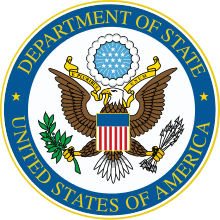United States Ambassador to Vietnam
| Ambassador of the United States to Vietnam
Đại sứ Hoa Kỳ tại Việt Nam | |
|---|---|
|
Seal of the United States Department of State | |
| Nominator | Barack Obama |
| Inaugural holder |
Pete Peterson as Ambassador Extraordinary and Plenipotentiary |
| Formation | April 11, 1997 |
| Website | U.S. Embassy - Hanoi |
The United States Ambassador to Vietnam (Vietnamese: Đại sứ Hoa Kỳ tại Việt Nam) is the chief American diplomat to the Socialist Republic of Vietnam. After the First Indochina War and the defeat of the French domination over Vietnam, the country was split into North and South Vietnam at the Geneva Conference of 1954. The United States did not recognize North Vietnam and thus had no diplomatic relations with the country. After the reunification of Vietnam in 1976, there followed a period of 20 years in which the United States had no diplomatic relations with Vietnam.
The U.S. opened a Liaison Office in Hanoi on January 28, 1995. Diplomatic relations were established July 11, 1995, and the embassy in Hanoi was established with L. Desaix Anderson as chargé d’affaires ad interim.
Ambassadors
U.S. diplomatic terms
After 1915, The United States Department of State began classifying ambassadors as career Foreign Service Officers (FSOs) for those who have served in the Foreign Service for a specified amount of time.
Political appointee
A person who is not a career foreign service officer, but is appointed by the president (often as a reward to political friends).
Appointed
The date that the ambassador took the oath of office; also known as “commissioning”. It follows confirmation of a presidential appointment by the Senate, or a Congressional-recess appointment by the president. In the case of a recess appointment, the ambassador requires subsequent confirmation by the Senate.
Presented credentials
The date that the ambassador presented his letter of credence to the head of state or appropriate authority of the receiving nation. At this time the ambassador officially becomes the representative of his country. This would normally occur a short time after the ambassador’s arrival on station. The host nation may reject the ambassador by not receiving the ambassador’s letter, but this occurs only rarely.
Terminated mission
Usually the date that the ambassador left the country. In some cases a letter of recall is presented, ending the ambassador’s commission, either as a means of diplomatic protest or because the diplomat is being reassigned elsewhere and replaced by another envoy.
Chargé d'affaires
The person in charge of the business of the embassy when there is no ambassador commissioned to the host country. See chargé d'affaires.
Ad interim
Latin phrase meaning "for the time being", "in the meantime". See ad interim.
- Pete Peterson – Political appointee[1]
- Appointed: April 11, 1997
- Title: Ambassador Extraordinary and Plenipotentiary
- Presented credentials: May 14, 1997
- Terminated mission: Left post July 15, 2001
- Raymond Burghardt – Career FSO
- Appointed: November 28, 2001
- Title: Ambassador Extraordinary and Plenipotentiary
- Presented credentials: February 5, 2002
- Terminated mission: 2004
- Michael W. Marine – Career FSO
- Title: Ambassador Extraordinary and Plenipotentiary
- Appointed: May 6, 2004
- Presented credentials: September 10, 2004
- Terminated mission: – August 10, 2007
- Michael W. Michalak – Career FSO[2]
- Title: Ambassador Extraordinary and Plenipotentiary
- Appointed: May 24, 2007
- Presented credentials: August 10, 2007
- Terminated mission: Left post February 14, 2011
- Virginia E. Palmer – Career FSO[3]
- Title: Chargé d'Affaires ad interim
- Appointed: February 14, 2011
- Presented credentials: February 14, 2011
- Terminated mission: July 2011
- David B. Shear – Career FSO[4]
- Title: Ambassador Extraordinary and Plenipotentiary
- Appointed: August 2011
- Presented credentials: August 29, 2011
- Terminated mission:
- Ted Osius – Career FSO[5]
Residence

The house used by the U.S. ambassador was designed by M. LaCollogne, Principal Architect and Chief of Civil Construction Service in Tonkin and built in 1921 by Indochina Public Property, part of the French colonial government, for Indochina Financial Governors who lived here until 1948. The house was then assigned, until 1954, to the highest-ranking Indochina Tariff Officer. When the French left South East Asia in 1954, Vietnamese government officials moved in. Vice Minister Phan Kế Toại was the last occupant; at his death, the house became the headquarters for the Committee for Foreign Culture Exchange. The Ministry of Foreign Affairs’ press office was located in the building until 1994. The residence was included in an exchange of property between the United States of America and the Socialist Republic of Vietnam in 1995.[8]
Notes
- ↑ An earlier nomination of May 23, 1996, was not acted upon by the Senate.
- ↑ Biography of Ambassador Michalak - U.S. Embassy Hanoi
- ↑ "Former Chargé d'Affaires". United States Department of State, U.S. Embassy Hanoi. Retrieved 2011-08-13.
- ↑ "Ambassador". United States Department of State, U.S. Embassy Hanoi. Retrieved 2011-08-13.
- ↑ Itkowitz, Colby (November 17, 2014). "Senate clears four ambassador nominees". Washington Post. Retrieved December 12, 2014.
- ↑ Lavers, Michael K. (December 10, 2014). "Gay man sworn in as U.S. ambassador to Vietnam". Washington Blade. Retrieved December 12, 2014.
- ↑ "New US Ambassador Arrives in Vietnam, Meets President". Thanh Nien News. December 17, 2014. Retrieved December 17, 2014.
- ↑ U.S. Department of State, The Secretary of State's Register of Culturally Significant Property, 2007.
See also
References
- United States Department of State: Background notes on Vietnam
 This article incorporates public domain material from the United States Department of State website http://www.state.gov/r/pa/ei/bgn/index.htm (Background Notes).
This article incorporates public domain material from the United States Department of State website http://www.state.gov/r/pa/ei/bgn/index.htm (Background Notes).
External links
- United States Department of State: Chiefs of Mission for Vietnam
- United States Department of State: Vietnam
- United States Embassy in Hanoi

